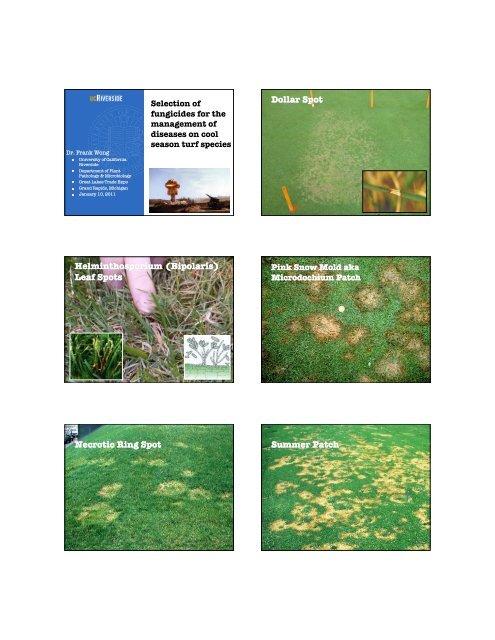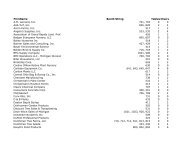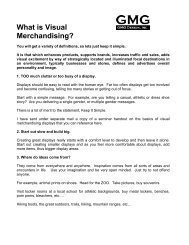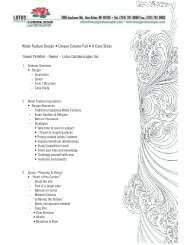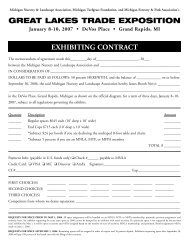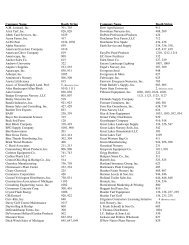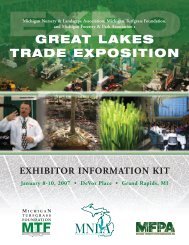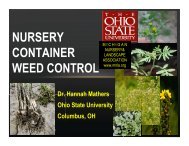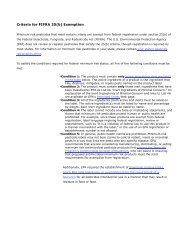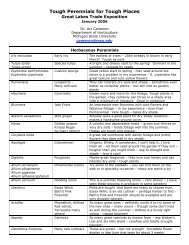Dollar Spot Helminthosporium (Bipolaris) Leaf Spots Necrotic Ring ...
Dollar Spot Helminthosporium (Bipolaris) Leaf Spots Necrotic Ring ...
Dollar Spot Helminthosporium (Bipolaris) Leaf Spots Necrotic Ring ...
Create successful ePaper yourself
Turn your PDF publications into a flip-book with our unique Google optimized e-Paper software.
Dr. Frank WongUniversity of CaliforniaRiversideDepartment of PlantPathology & MicrobiologyGreat Lakes Trade ExpoGrand Rapids, MichiganJanuary 10, 2011Selection offungicides for themanagement ofdiseases on coolseason turf species<strong>Dollar</strong> <strong>Spot</strong>www.turfpathology.ucr.edu<strong>Helminthosporium</strong> (<strong>Bipolaris</strong>)<strong>Leaf</strong> <strong>Spot</strong>sPink Snow Mold akaMicrodochium Patchwww.turfpathology.ucr.eduwww.turfpathology.ucr.edu<strong>Necrotic</strong> <strong>Ring</strong> <strong>Spot</strong>Summer Patchwww.turfpathology.ucr.eduwww.turfpathology.ucr.edu
Choosing the Right FungicidesMulti-site InhibitorsFungicides will be discussed in thecontext of the most common diseases ofcool season landscape turf in the MidwestAscomycetes: <strong>Dollar</strong> <strong>Spot</strong>,<strong>Helminthosporium</strong> <strong>Leaf</strong> <strong>Spot</strong>, Pink SnowMold, <strong>Necrotic</strong> <strong>Ring</strong> <strong>Spot</strong>, Summer PatchBasidiomycetes: Brown Patch, RedThread, Rust, SmutOomycetes: Pythium BlightMany work bybreaking themolecularbonds that holdproteinstogetherOthers smotheror otherwisephysicallydamage thefungusSSSHSHwww.turfpathology.ucr.eduwww.turfpathology.ucr.eduEBDCsChlorothalanilSulfurCopper ++Multi-site InhibitorsSingle-site InhibitorsAffect aspecificmetabolicprocessBind toproteins via“lock and key”processwww.turfpathology.ucr.eduwww.turfpathology.ucr.eduSingle-site InhibitorsAmino Acid andProtein SynthesisAnilinopyrimidinesSterol BiosynthesisDMIsRespiration(MET complex III)QoIsOsmoregulation(unknown)PhenylpyrrolesLipid BiosynthesisSub. AromaticHydrocarbonsDicarboxymidesmRNA SynthesisPhenylamidesNuclear DivisionBenzimidazolesRespiration (METcomplex II)Carboxinswww.turfpathology.ucr.eduSystemicityNon-systemicDo not penetrate intoplantRedistribute on plantsurfacesMulti-site inhibitorsKills spores/inhibitsgerminationProtectant onlyBroad spectrumSystemicPenetrate into plantRedistribute on & withinplantsSingle-site inhibitorsInhibits spore germinationand or mycelial growthProtectant and curativeSelectivewww.turfpathology.ucr.edu
Group 2: DicarboximidesTreatedUntreatedGroup 2: DicarboximidesProsStrong vs <strong>Dollar</strong> <strong>Spot</strong>, <strong>Leaf</strong> <strong>Spot</strong>, Pink SnowMoldStrong vs Brown Patch, Red ThreadConsLocal penetrant activity onlyNo activity vs most root diseases, fairy ringNo Pythium activityTolerance for some dollar spotwww.turfpathology.ucr.eduwww.turfpathology.ucr.eduGroup 3 FungicidesSterol DemethylationInhibitors“Good enough for myfeet and manyAscomycete andBasidiomycetediseases”Group 3: DMI FungicidesInhibit demethylation of ergosterol used in cellmembranesCalled SBI, SI or DMI fungicidesWidely used for plants, animals and medical purposesSystemic, acropetal penetrant fungicidesFenarimol - RubiganMyclobutanil - EaglePropiconazole - Banner MAXXTebuconazole - TorqueTriadimefon – StrikeTriticonazole – Trinity, Tritonwww.turfpathology.ucr.eduUntreatedTreatedGroup 3: DMI FungicidesProsBroad spectrum of activity vs ascomycete andbasdiomycete fungiSystemicLasting residual activity & long applicationintervalsConsSome plant growth regulator effects at high ratesor high temperaturesDevelopment of tolerance for some diseaseswww.turfpathology.ucr.eduwww.turfpathology.ucr.edu
Group 11: Qo-InhibitorsQoIs shut downrespiration inmitochondiraStrongest vs. sporegerminationSome have strongercurative orsystemic propertiesthan othersGroup 11: QoIsProsSome can control Asocomycete, Basidiomyceteand Oomycete diseasesConsAzoxystrobin has no effect on dollar spot; othersare only moderately effectiveTrifloxystrobin not very effective vs root and soildiseasesResistance present for some diseaseswww.turfpathology.ucr.eduwww.turfpathology.ucr.eduGroup 12FungicidesPhenylpyrroles“Nature’s gift vs.Rhizoctonia and SnowMolds”Group 12: PhenylpyrrolesFunction by inhibiting osmotic regulationpathways in fungi (os-1)Derived from a natural product derivedfrom a soil PseudomonadLocal penetrant fungicideGood soil stabilityFludioxonil (Medallion)www.turfpathology.ucr.eduTreatedUntreatedGroup 12: PhenylpyrrolesProsStrong vs Rhizoctonias and Pink Snow MoldActive vs Helminth. <strong>Leaf</strong> <strong>Spot</strong>ConsLocal penetrant activity only, strongest as apreventive applicationLimited activity vs. Summer PatchNo activity vs. Oomycetes, dollar spotLimited to 1.5 oz/1,000 sq ft per year (4 lb/A)www.turfpathology.ucr.eduwww.turfpathology.ucr.edu
Group 4, 21, 28, 33and 43 FungicidesPhenylamides, QiisCarbamates,Phosphonates andBenzimides –“The PythiumSpecialists”Group 4 : PhenylamidesThese areOoymcetespecificfungicidesMefenoxam -Subdue MAXXInhibits RNApolymerase andproteinsynthesiswww.turfpathology.ucr.eduGroups 4, 21, 28, 33, and 43:The Pythium SpecialistsThese only control Oomycete diseasesMost Pythium speciesDowny mildewThese 5 classes are diverse and havedifferent modes of action/resistanceGroup 4 : PhenylamidesProsVery effective vs Pythium, Phytophthora, andDowny MildewsStrong protectant and curative activityConsDoes not work against Ascomycetes &BasidiomycetesResistance likely if over usedwww.turfpathology.ucr.eduwww.turfpathology.ucr.eduGroup 21: Qi-InhibitorsAffects mitochondrial respiration; sameenzyme as the QoIs, but on the “inside”binding siteSystemic and curative propertiesCyazofamid (Segway)Only affects OomycetesGroup 28: CarbamatesPropamocarb (Banol)Inhibits lipid biosynthesisEffective only against zoosporesNon-systemic, protectant mode of actionBest against foliar Pythiumswww.turfpathology.ucr.eduwww.turfpathology.ucr.edu
Group 33: PhosphonatesUnknown mode of actionUnique that they can move upwards anddownwardsFosetyl-Al (Aliette, Signature)AI activated inside the plant by breakdown of the moleculeto a phosphite ionFungistatic activity of PO 3- ion and plant defense activationBest used as a preventive applicationPigment in Signature may reduce plant stressPhosphite salts (Alude)“Active” form of the phosphite ionwww.turfpathology.ucr.eduGroup 43: BenzimidesNew fungicidereleased in2008/9Inhibits spectrinformationFlucopicolide(Stellar):premixed withpropamocarbS. Berg, Winona State Univ.www.turfpathology.ucr.eduGroup 43: BenzimidesLimited systemicactivityLimited curativeabilityGroup 44Microbials“Bacteria with theirown fungicidefactories”S. Berg, Winona State Univ.www.turfpathology.ucr.eduGroup 44: MicrobialsBacillus subtilis bacteria formulated aspesticide (Serenade, Companion, etc.)These produce lipopeptides that disruptfungal cell membranesCan be effective vs. <strong>Dollar</strong> <strong>Spot</strong>, BrownPatch, RustBest as a preventive foliar materialMay require short application intervalsMay break under heavy disease pressureCombinationFungicides“Multi-purpose in ajar”www.turfpathology.ucr.edu
Combination FungicidesMixtures combine the effectiveness ofdifferent fungicides for broad-spectrumactivityUseful and avoids having to tank-mixKnow the properties of the tank mixpartnersSometimes single components in the pre-mix are not highenough to provide effective control of a diseaseBoth components need to work against the target diseaseExample: Headway vs <strong>Dollar</strong> <strong>Spot</strong>Combination FungicidesAnti-resistance?Sort ofTwo or more components reduce the risk ofapplication failureNon-systemic and systemic components canbecome separated in the plant; low doses maynot provide effective controlwww.turfpathology.ucr.eduwww.turfpathology.ucr.eduQuestions???www.turfpathology.ucr.edu
Ascomycetes Basidiomyc. Oomyc.Notes: X = fungicide labeled for disease control or has shown activity in University trials. Refer to productlabel for exact application instructionsFungicide Selection for Diseases of Cool Season Turf 2011Group ChemicalClassFRAC ClassResistance RiskProductExamples<strong>Dollar</strong> <strong>Spot</strong><strong>Helminthosporium</strong><strong>Leaf</strong> <strong>Spot</strong>Pink Snow Mold<strong>Necrotic</strong> <strong>Ring</strong> <strong>Spot</strong>Summer PatchBrown PatchRed ThreadRustSmutFairy <strong>Ring</strong>Pythium BlightMultisiteSingle-sitecopper hydroxide copper M1 none ---mancozeb dithio-carbamate M3 noneDithane,ForeX X X X X Xthiram <strong>Spot</strong>rete X X X Xcaptan phthalamide M4 none Captan Xchlorothalonil chloronitrile M5 none Daconil X X X X X Xhydrogen dixoide --- --- none Zero-Tol X X X X X Xmineral oil --- --- none Civitas X X X X X Xthiophanate-methyl MBC 1 highClearys3336X X X X X X X X XChipcoiprodionemediumhighX X X X Xdicarboximide 226GTvinclozlinCuralan X X X X Xfenarimol Rubigan X X X X X X Xmetconazole Tourney X X X X X X X Xmyclobutanil Eagle X X X X X X X X X XpropiconazoleDMI 3 mediumBannerMAXXX X X X X X X X X Xtriadimefon Bayleton X X X X X X X X Xtebuconazole Torque X X X X X X X X X XtriticonazoleTrinity,TritonX X X X X X X X Xmefenoxam phenylamide 4 highSubdueMAXXX
Ascomycetes Basidiomyc. Oomyc.Notes: X = fungicide labeled for disease control or has shown activity in University trials. Refer to productlabel for exact application instructionsFungicide Selection for Diseases of Cool Season Turf 2011Group ChemicalClassFRAC ClassResistance RiskProductExamples<strong>Dollar</strong> <strong>Spot</strong><strong>Helminthosporium</strong><strong>Leaf</strong> <strong>Spot</strong>Pink Snow Mold<strong>Necrotic</strong> <strong>Ring</strong> <strong>Spot</strong>Summer PatchBrown PatchRed ThreadRustSmutFairy <strong>Ring</strong>Pythium BlightSingle-siteboscalidflutolanilSDHI 7azoxystrobin Heritage X X X X X X X X Xfluoxastrobin QoIhigh Disarm X X X X X X X X X11pyraclostrobin Insignia X X X X X X X X XetridiazolePCNBaromatichydrocarbon14polyoxin-D polyoxins 19 mediumcyazofamid Qii 21mediumhighEmerald Xmedium ProStar X X XtrifloxystrobinCompass X X X X X X Xlowmediumfludioxonil phenylpyrrole 12Medallion X X X Xchloroneb Terraneb X XlowmediummediumhighKoban,TerrazoleTerraclor X X XAffirm,EndorseX X X XSegway Xpropamocarb carbamate 28 medium Banol Xfosetyl-AlAliette,phosphonate 33 low SignatureXphosphite saltsAlude Xfluopicolide benzimide 43 medium ---X
Ascomycetes Basidiomyc. Oomyc.Notes: X = fungicide labeled for disease control or has shown activity in University trials. Refer to productlabel for exact application instructionsFungicide Selection for Diseases of Cool Season Turf 2011Group ChemicalClassFRAC ClassResistance RiskProductExamples<strong>Dollar</strong> <strong>Spot</strong><strong>Helminthosporium</strong><strong>Leaf</strong> <strong>Spot</strong>Pink Snow Mold<strong>Necrotic</strong> <strong>Ring</strong> <strong>Spot</strong>Summer PatchBrown PatchRed ThreadRustSmutFairy <strong>Ring</strong>Pythium BlightMicrobialsCombinationBacillus subtillus microbial 44 low Rhapsody X X Xazoxystrobin +chlorothalonilazoxystrobin +propiconazolechlorothalonil +fludioxonil +propiconazolechlorothalonil +propiconazolecopper hydroxide +mancozebfluoxastrobin +chlorothalonilfluopicolide +propamocarbpyraclostrobin +boscalidmancozeb+myclobutanilthiophanate-methyl +chlorothaloniltrifloxystrobin +triadimefontriticonazole +chlorothalonilQoI +chloronitrile11 + M5 Renown X X X X X X XQoI + DMI 11 + 3 Headway X X X X X X X X X Xchloronitrilebenzimide +carbamateM5 +12 + 3Instrata X X X X X X XM5 + 3 Concert X X X X X XM1 + M3 Junction X X X X X X11 + M5 Disarm C X X X X X X X X Xspecial43 + 28 Stellar XQoI + SDHI 11 + 7 Honor X X X X X X X X X Xdithiocarbamate+ DMIMCB +chloronitrileQoI +DMIDMI +chloronitrileM3 + 3chloronitrile +phenylpyrrole +DMIchloronitrile +DMIcopper + diothiocarbamateQoI +MANhandleX X X X X X X1 + M5 Spectro X X X X X X X11 + 33 + M5Armada,TartanX X X X X X X XReserve X X X X X X X X


